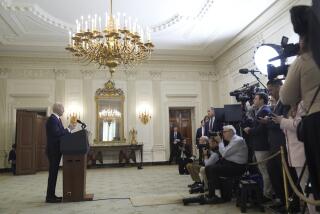The future of media
- Share via
The Federal Communications Commission’s latest effort to relax the rules on media ownership is so modest, it’s surprising how much flak the agency has taken for it. Unlike the sweeping deregulation adopted in 2003, which was largely countermanded by Congress and the courts, the proposal last month by FCC Chairman Kevin J. Martin would ease only one restriction: the 1975 rule against radio or television broadcasters owning local newspapers in the same market.
We at The Times have an interest in eliminating that ban. Our parent company, Tribune Co., owns a local newspaper and one or more broadcasters in five markets, including this one. But Martin’s limited proposal wouldn’t bless Tribune’s current arrangements in Connecticut, where it owns a newspaper and two broadcasters. Instead, the proposal would allow mergers only if they were limited to a single TV or radio station in a market, though they would be subject to other restrictions. (The FCC temporarily waived the cross-ownership ban for Tribune’s properties last week, when it transferred the company’s TV and radio licenses to a group of new owners led by real estate magnate Sam Zell.)
Nevertheless, critics complain that the proposal would lead to more media consolidation at the expense of minority and female owners. Their allies on Capitol Hill are pressing the commission not to vote on the proposal this month, as Martin would like to do, but instead to conduct more research into promoting local content and broadening the ranks of media owners.
Whatever the implications for Tribune, the ban on newspaper-broadcaster cross-ownership does little to further the goal of promoting diverse sources of news and information. It’s a relic of an age when those outlets not only had the most influence but also had nearly exclusive access to the public’s eyes and ears. In 1970, when the cross-ownership ban was proposed, 95% of TV viewers were tuned to one of the three major TV networks during prime time, and nearly 80% of adults read newspapers. Today, the barriers to entry into the news business have been eradicated by the Internet. Anyone can publish news and build an audience for it, with the help of search engines and online news readers. They may not have the impact of traditional media outlets, but their numbers are heading in the right direction -- which can’t be said for their ink-stained competitors.
The best thing government can do to broaden diversity in media is to improve the public’s access to the Internet and other open publishing platforms. That includes promoting competition in broadband and making it easier for programmers to get onto cable and wireless networks. As newspaper circulation and TV viewership continue to decline, the battle that matters won’t be to control those outlets. It will be to replace them.
More to Read
The biggest entertainment stories
Get our big stories about Hollywood, film, television, music, arts, culture and more right in your inbox as soon as they publish.
You may occasionally receive promotional content from the Los Angeles Times.










